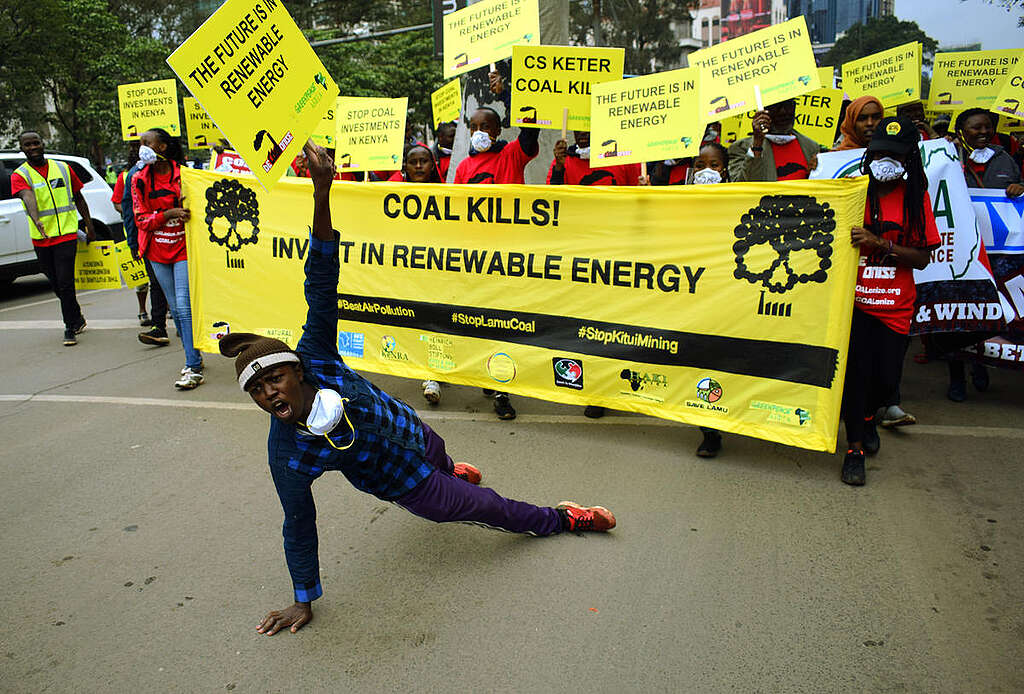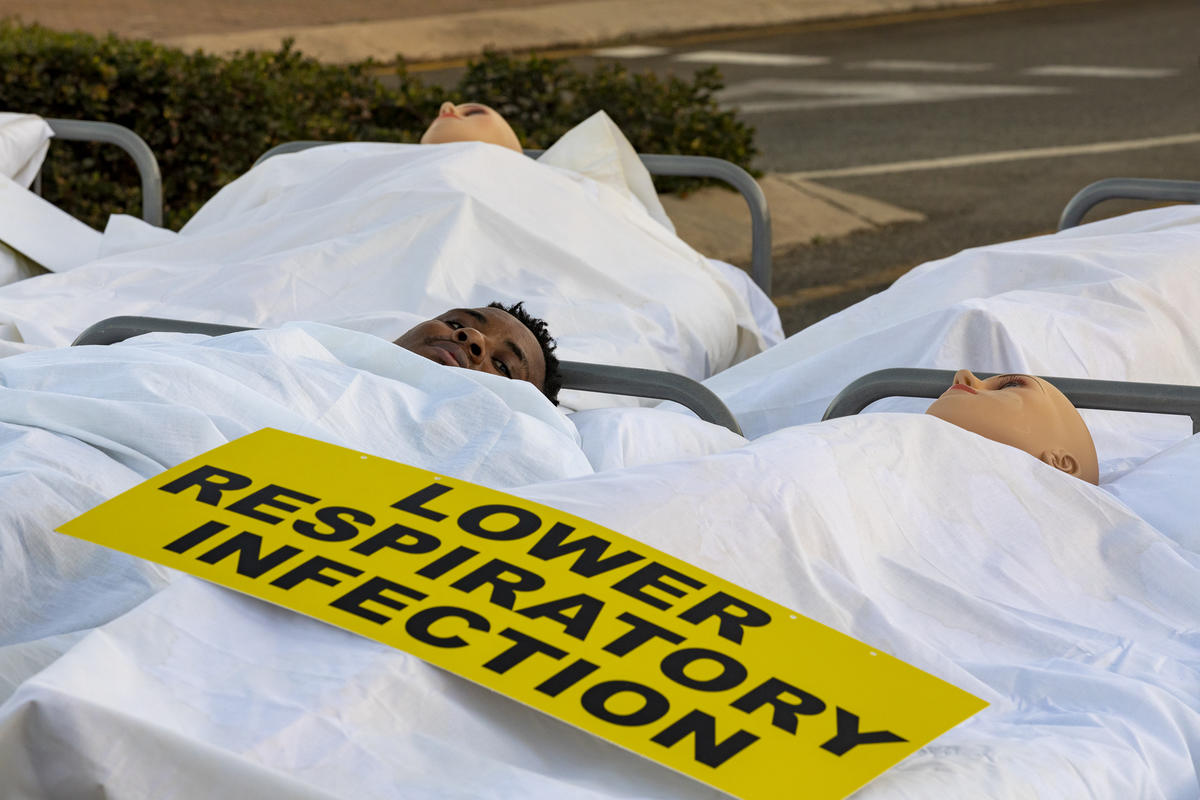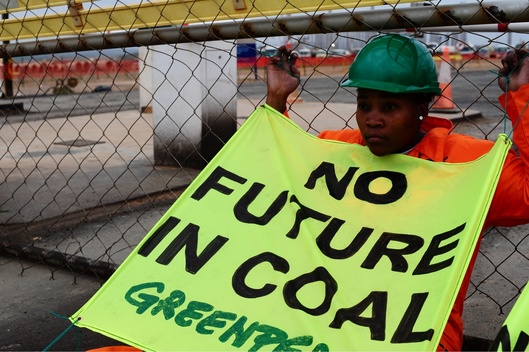PRESS RELEASE
For media enquiries, phone/whatsapp: +34682398702; +447479234522
email: [email protected], [email protected], [email protected]
Links: Timeline of key events so far and upcoming, media archive with photos and videos
Fridays for future Windhoek: facebook, twitter, instagram
March 2021 (Windhoek, Namibia) – Fridays For Future Windhoek revealed that the oil and gas ‘play’ of Canadian ReconAfrica in the Kavango region of Namibia and Botswana risks destroying global attempts of meeting a two-thirds chance of limiting global heating to 1.5°C as part of the Paris Climate Change Agreement.
Based on ReconAfrica’s own projections of 120 billion barrels of oil equivalent, the ‘carbon gigabomb’ comes in at up to 51.6 Gigatonnes of CO2, the equivalent of one sixth of the world’s remaining carbon budget. [1 – table] A crude analysis across the potential 25 year life cycle of the project shows Namibia and Botswana combined entering the top ten countries by oil production: fourth after Saudi Arabia and before Iraq. [2]
Fridays for Future Windhoek says it is completely inconsistent for the governments of Namibia and Botswana to claim to be reducing emissions and upholding the Paris Agreement while letting this project go ahead. Last week, the UN admitted that countries’ pledges to cut emissions are woefully inadequate to prevent a climate and ecological disaster – just months out from the UN’s African Climate Week and seven months before COP26 in Glasgow.
To put things in perspective, Botswana and Namibia together emitted around 0.014 Gt CO2 in 2019. [1] Namibia – which has a 10 per cent share in ReconAfrica’s Namibian findings – has said it intends to cut greenhouse gas emissions by 89% by 2030, while the government of Botswana is aiming for a reduction of 15% by 2030. [1].
“Children have the right to a future on a habitable and healthy planet, whether they live in Frankfurt, Houston, Rundu or Vancouver,” commented Ina-Maria Shikongo of Fridays for Future Windhoek. “Promises on climate regulations in the global North ring empty when all companies affected by them have to do is find a country somewhere needing a financial boost and with great exploitation potential. Nowhere is this more evident than in the Kavango, where under cover of COVID-19, oil and gas are rushing to cash-in on what they suspect is the last great fossil fuel find, as oil prices plummet amidst a glut. Already Southern Africa is experiencing record temperature hikes and severe water shortages, more than other regions on the planet. That’s why this Friday we join with other climate strikers around the world in demanding a moratorium on all new fossil fuel projects.”
Daniel Jarvie, ReconAfrica’s geochemist said: “Africa is the final frontier for oil discoveries because it’s so vastly under-explored and we could even be looking at the last major onshore oil discovery on Earth.” [3]
Largest oil play of the decade in the Jewel of the Kalahari
ReconAfrica (TSX-V: RECO; OTCQX: RECAF; Frankfurt: 0XD) has an exploratory license covering 34,325 sq km (8.5 million acres) across northeast Namibia and northwest Botswana for what it considers to be the ‘largest oil play of the decade’ – conventional and unconventional. [3] ReconAfrica is already breaking ground, placing the pristine ecosystem and communities’ livelihoods of the Kavango region under grave threat. This directly affects the Okavango Delta, one of the planet’s last great life lines and the subject of many nature documentaries with its inland delta, the beating heart of the Kalahari Desert. [4]
“As the custodians of this land for thousands of years and the rightful current inhabitants, we’ve never been consulted, nor have we given the go-ahead to any entities to prospect for oil and gas,” laments Q7 Beckett, San youth leader. “Any consequent production will irrevocably damage our life-giving water and the fragile ecosystem we depend on as a people. The presence of the oil industry will mean the forceful enclosure of land; excluding us and preventing our free movement and that of animals; and resulting in our further displacement. In this way we will be prevented from hunting and gathering food, collecting medicine and performing our cultural practices and sacred rituals – in short it will prevent us from being San.”
Perhaps now is not the time to get into fossil fuels?
The fate of one of Africa’s most valuable ecosystems – and the world’s – may depend on the choices made now. 2021 is a crucial year as the combined emergencies we face coalesce. Life affirming pathways are already here, mainstream Western society is now finding common cause with indigenous wisdom.
The Beyond Petrostates’ Report shows the bottom is dropping from fossil fuels, while PCW’s 2020 Africa Oil and Gas Review states: “Accelerated adoption of renewable energy could be the economic game changer for many African countries. Renewable energy industries have been shown to have positive and inclusive economic impact.” [5] [6]
Khoe San youth activist and environmental scientist, Sharri Cannell, summarises explaining how “the solutions to our traumas are already here. They have always been here, in spite of ‘development’. They are in our heart, in our earth, in our nature, available to all of us, if we just listen to the dying planet and each other. We are all inextricably linked, and what we do to others we do to ourselves. The buck must stop here, if we so desire. What happens in the Kalahari will not stay in the Kalahari, and the poison threatening my people will fill the atmosphere and threaten you someday very soon. We all need to come together and seek solutions to problems created by a few, in the name of and at the cost of so many.”
FURTHER QUOTES
Marta G. Rivera Ferre, Chair Agroecology and Food Systems & IPCC author, said:
“Carbon intensive emissions projects are not part of our future. COVID-19 has shown that governments can listen to the science. We need to learn from this pandemic and ensure that governments listen to scientists on the climate and ecological emergency. So, as the world begins to focus towards COP26, let’s act now to protect the natural places and their biodiversity, and keep the carbon in the ground. The impossible can happen if there is political will, we need to not only limit warming to 1.5C, but push it lower.”
Jan Arkert, a consulting engineering geologist based in Uniondale, South Africa, who has worked for decades on drilling-related projects:
“Despite denials in Botswana and Namibia that fracking will occur, this technique must be applied to determine the extent of any shale oil or gas reservoir, and the viability of extracting these. Should said viability be proven, fracking will be required to release the fossil fuels from the shale. Even if fracking is not engaged, the 25 to 30 year period anticipated for conventional shale oil/gas extraction will inevitably result in carbon dioxide being released into the atmosphere, and more critically, methane extracted as fugitive emissions. Similarly, the very real potential of the groundwater level and contamination due to unlined ponds, which hold radioactive brine, could significantly impact the agricultural, the people and wildlife of Kavango.” [7]
“This comes without consideration to the vast quantity of water required for fracking, or the geohydrological characteristics of the aquifers, exposed to unlined wells next to pits, as is already the case.”
Ndaundika Shefeni, of SOUL (an international civil society organisations and activists promoting climate and environmental justice) in Namibia:
“It makes no sense to potentially contaminate groundwater resources, harm viable ecosystems, agricultural land, and disrupt existing economic activities in Namibia and Botswana for foreign owned companies to make large financial gains. As opposition grows across the region and world, unlikely alliances are forming of spiritual leaders, cultural organisations, conservation charities and grassroot community groups, ReconAfrica is engaging in tactics they would never dare to commit in their own country, like threatening media and community members with lawsuits, as reported by NatGeo and The Namibian.”
Joy Soita Juma , Oilwatch Africa Coordinator based in Nairobi Kenya
“The world is interconnected. Through oil and gas companies, their funders and those who will make money out of it, places like Kavango are connected to Canada, the US, the UK and Germany where companies may be listed or headquartered. They are also connected to the world through potential CO2 emissions which, as we head towards COP26 in Glasgow, will demonstrate how we really are all in this together. The area identified for potential drilling also belongs to the largest cross-border nature conservation area in the world, Kavango–Zambezi Transfrontier Conservation Area (KAZA), situated where the international borders of five countries converge – Angola, Botswana, Namibia, Zambia and Zimbabwe – with this park itself receiving investment from Germany and the US. What happens in Kavango doesn’t stay in Kavango.”
Daniel Jarvie, ReconAfrica’s geochemist
“In the report, just released, I put total petroleum generation potential over Recon’s 8.75 million acres at 120 billion boe (Barrels of Oil Equivalent). Now, that’s only looking at 1,641 sections, which represents only 12% of Recon’s total holdings in the basin. As I’ve said, I’ve been conservative with the numbers, and even so, if the potential pans out in full, they are pretty comparable to the Permian Wolfcamp and the Eagle Ford in Texas. The bottom line is this: The Kavango Basin has all the characteristics necessary for conventional and unconventional petroleum systems. Although I’m known for my unconventional work, I’m actually hopeful that the conventional exceeds the unconventional. Why? Because conventional reservoirs are inherently more productive.” [3]
Chevron CEO Mike Wirth in an interview with analysts published in worldoil.com
“If conditions in the U.S. become so onerous that it really disincentivizes investment we’ve got other places we can take those dollars.”
Notes to editors
About Friday’s For Future
The global climate strike movement began in August 2018, when then 15-year-old Greta Thunberg began to skip class on Fridays and sat outside the Swedish parliament to demand her government took the climate situation seriously . In the three weeks leading up to the Swedish election, she sat outside Swedish Parliament every school day, demanding urgent action on the climate crisis. She was tired of society’s unwillingness to see the climate crisis for what it is: a crisis. Soon, youths across the world joined her example, taking their future into their hands and inspiring peaceful marches across the planet.
FFF’s principal goal is to place moral pressure on policymakers, and demand they listen to the scientists, so as to take forceful action to limit global heating. FFF is independent of commercial interests and ideology and knows no borders. FFF protests for our planet and for each other. There is reason to hope humanity can change and avert the worst of climate disasters, and build a better future.
Established in 2019 Friday’s For Future Windhoek seeks to raise awareness among Namibians of the Climate and Ecological Emergency. The locally lead youth organisation has rallied behind calls to stop oil and gas drilling in Namibia’s treasured Kavango region to avert a true planetary disaster in our own backyard.
[1] Table comparing the ‘remaining’ global carbon budget to potential emissions from ReconAfrica’s proposed project, including supplementary information.
| Subject | Numbers | Workings/References |
| In 2019, 420 GtCO2 ‘remaining’ in the carbon budget for a two-thirds chance of limiting warming to 1.5°C | 420 Gt | The IPCC in 2018 “suggests a remaining budget of about 420 GtCO2 for a two-thirds chance of limiting warming to 1.5°C, and of about 580 GtCO2 for an even chance (medium confidence). https://www.ipcc.ch/sr15/chapter/chapter-2/ In this analysis we are not including negative emissions based on technology that has not been invented yet, due to concerns that this is placing undue reliance that children of the future will pay after 2050 for what the adults of the world didn’t do now. |
| Less estimated annual emissions of 40 Gt of CO2 per year for 2018, 2019, 2020 | 2021 remaining:<300 Gt 2018 – 41.5 Gt2019 – 43.1 Gt2020 – 39 Gt | https://www.theguardian.com/commentisfree/2021/mar/09/its-unavoidable-we-must-ban-fossil-fuels-to-save-our-planet-heres-how-we-do-it 2018 – 41.5 billion tonnes of CO2.https://www.globalcarbonproject.org/carbonbudget/archive/2018/UK_UEA_GCPBudget2018.pdf 2019 – 43.1 billion ton (range 39.9 to 46.2 Gt CO2) in 2019 https://www.globalcarbonproject.org/carbonbudget/archive/2019/Japan_NIES_GCB2019.pdf2020 – 39 GtCO2 – Slight dip due to coronavirus pandemichttps://www.globalcarbonproject.org/carbonbudget/20/files/UK_UEA-Exeter_GCB2020.pdf |
| There’s a glut!Proved fossil fuel reserves reported in British Petroleum’s Statistical Review of World Energy with CO2 emission factors from the IPCC yields 3,600 Gt of CO2 emissions. This means that we can only afford to burn one twelfth of the fossil fuels we have already found. | 3,600 Gt | https://www.theguardian.com/commentisfree/2021/mar/09/its-unavoidable-we-must-ban-fossil-fuels-to-save-our-planet-heres-how-we-do-it https://www.bp.com/content/dam/bp/business-sites/en/global/corporate/pdfs/energy-economics/statistical-review/bp-stats-review-2020-full-report.pdf |
| Namibian government’s promises in its Intended Nationally Determined Contribution to the UNFCCC in 2018 | 0.02 Gt | Excerpt from INDC: “Namibia aims at a reduction of about 89% of its GHG emissions at the 2030 time horizon compared to the BAU scenario. The projected GHG emissions to be avoided in 2030 is of the order of 20000 Gg CO2-eq (0.02 Gt) inclusive of sequestration in the AFOLU sector and compared to the BAU scenario”https://www4.unfccc.int/sites/ndcstaging/PublishedDocuments/Namibia%20First/INDC%20of%20Namibia%20Final%20pdf.pdf Further excerpt: “Namibia as a Non-Annex I Party to the UNFCCC does not have commitments under the Convention. However, Namibia takes climate change issues seriously and the submission of the INDC is a clear testimony that the country is committed to fight climate change. To this end, Namibia has put in place policies and strategies to deal with the adverse impacts of climate change. We see climate change as a major threat to the economic development and the general welfare of the Namibian society.”https://www4.unfccc.int/sites/ndcstaging/PublishedDocuments/Namibia%20First/INDC%20of%20Namibia%20Final%20pdf.pdf |
| Botswana government’s promises in its INDC to the UNFCCC in 2018 | 0.008307 Gt | Botswana intends to achieve an overall emissions reduction of 15% by 2030, taking 2010 as the base year. Base year emission estimation is 8307 Gg of CO2 equivalent.https://www4.unfccc.int/sites/ndcstaging/PublishedDocuments/Botswana%20First/BOTSWANA.pdf |
| What are the potential CO2 emissions of the ReconAfrica project? | Up to 51.6 Gt | ReconAfrica projects that there are 120 billion barrels of oil equivalent in the Kavango Basin, you can see this in presentations and interviews. https://reconafrica.com/wp-content/uploads/ReconAfrica-Postulated-Petroleum-Yields-V2.pdfWhile the numbers are big, using the US Environmental Protection Agency’s 2019 guidance, it is a relatively easy task to work out what that means in terms of CO2.0.43 metric tons equates to CO2 per barrel, which means that 120 billion barrels of oil equivalent.Equates to about 51.6 Gigatonnes of CO2. equates to 120 billion barrels of oil equivalent.https://www.epa.gov/energy/greenhouse-gases-equivalencies-calculator-calculations-and-references It is important to note that at the moment it isn’t clear how much of that potential find is oil vs gas. As gas has a slightly lower CO2 emissions factor than oil, to make estimates as accessible to people as possible – given this is big numbers we are dealing with – we have opted to say up to 51.6 Gigatonnes. If the full discovery were gas rather than oil, we can convert 120 billion boe to bcf and then tCO2 using the factors of 1 boe = 5800 cf and 1 bcf = 59,726 tCO2 from the IPCC. This results in a minimum estimate of 41.6 Gigatonnes tCO2, still wholly incompatible with a liveable climate. |
| 0.014 Gt | For perspective Botswana and Namibia together currently emit around 13 million tons (0.013 Gt) of carbon per year.https://op.europa.eu/en/publication-detail/-/publication/71b9adf3-f3dc-11ea-991b-01aa75ed71a1Namibia – 2019 4.400 MtCO2/yrBotswana – 2019 – 7.039 MtCO2/yrCombined for 2019 11.439 MtCO2/yr (0.0114 Gt) | |
| Carbon budget is likely smaller than we think it is | 100Gt | The IPCC estimate in SR1.5 “suggests that the [carbon] budget could be further reduced by up to 100GtCO2 in 2100 due to Earth-system feedbacks, such as carbon released by thawing permafrost that is generally not included in climate models.” https://www.carbonbrief.org/analysis-why-the-ipcc-1-5c-report-expanded-the-carbon-budget |
| Synthesis NDC report | https://www.gov.uk/government/news/statement-by-cop26-president-alok-sharma-on-the-ndc-synthesis-report |
[2] Combined that would be Botswana and Namibia = 120 bboe / 25 years = 4.8 billion barrels a year https://www.offshore-technology.com/features/oil-production-by-country/
[3] Daniel Jarvie interview 1 September 2020 https://oilprice.com/Interviews/The-Largest-Oil-Play-Of-The-Decade-Interview-With-Daniel-Jarvie.html#join-discussion
[4] Documentaries on the wildlife and biodiversity of the Okavango
- https://www.forbes.com/sites/jenniferhicks/2018/12/23/these-two-documentaries-show-the-importance-of-conservation-in-the-okavango-delta/amp/
- The Flood – trailer here https://www.youtube.com/watch?v=BUBoLiLhCh8
- Into the Okavango – https://en.m.wikipedia.org/wiki/Into_the_Okavango. Trailer here https://www.youtube.com/watch?v=SXVohy5eAP8
- Okavango River of Dreams – https://m.imdb.com/title/tt10761742/ – Part 1 https://www.dailymotion.com/video/x7ub6z8
- On netflix you can catch the Planet Earth series and the Great Migration
[5] https://carbontracker.org/reports/petrostates-energy-transition-report/
[6] https://www.pwc.co.za/en/press-room/africa-oil-and-gas-review-2020.html
[7] Toxicity in the oil and gas industry
- Article on the lack of lining of the well ponds in National Geographic – Test drilling for oil in Namibia’s Okavango region poses toxic risk https://www.nationalgeographic.com/animals/article/test-drilling-oil-namibia-poses-water-risk
- Documentary: The High Cost of Cheap Gas. This investigation, filmed in Botswana, South Africa and North America, reveals how gas companies are quietly invading some of the most protected places on the planet https://youtube.com/watch?v=qUVjs0b49o4
- Rolling Stone investigation – ‘America’s Radioactive Secret’ – Oil-and-gas wells produce nearly a trillion gallons of toxic waste a year. An investigation shows how it could be making workers sick and contaminating communities across America https://www.rollingstone.com/politics/politics-features/oil-gas-fracking-radioactive-investigation-937389/
- How fracking plans could affect shared water resources in southern Africa https://theconversation.com/how-fracking-plans-could-affect-shared-water-resources-in-southern-africa-147684
- National Geographic – Oil drilling, possible fracking planned for Okavango region—elephants’ last stronghold
- Fracking the Okavango documentary – https://allianceearth.org/fracking-the-okavango/




